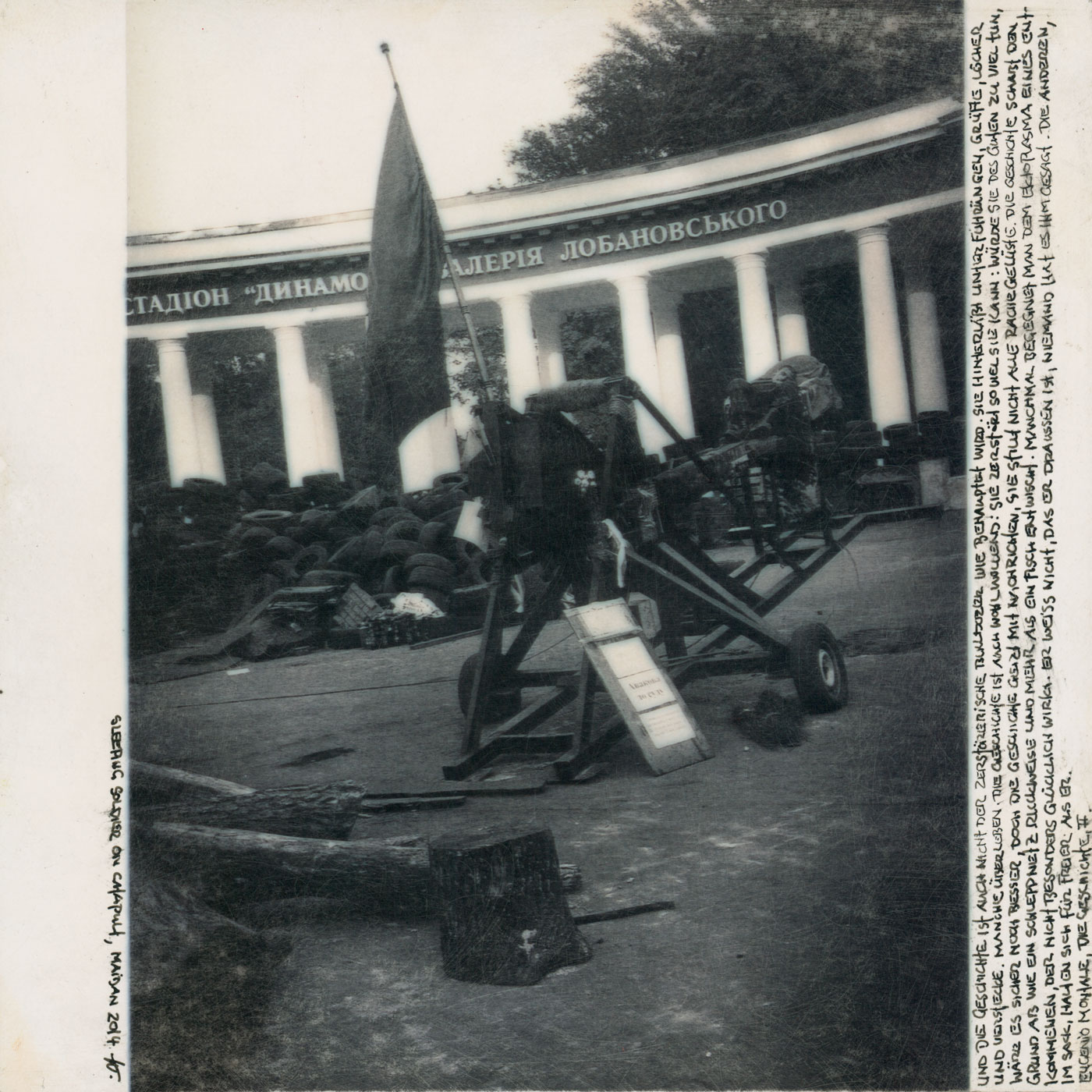Materialsammlung
mīgozarād [it will pass]
written on a teahouse-wall in Kunduz
“I maintain the principle that the duration of peace stands in direct proportion to the slaughter of the enemy. The harder you strike them, the longer they will hold on”
General Skobelev/Russia (commanded the massacre of the Turkmen fortifications at Göp-Teke in 1881. He allowed his troops to pillage and plunder for three days. 15,000 defenders and their families were slaughtered.)
What defines an individual without connections? The definition comes from a daily reality continually occupied by the impossibility of travel and the successive fractures of love, by the utopia of reconstruction and cohabitation with horror, by the inexistence of the future and the violation of citizenship, by the death of dreams and the corrosion of objects, by the exhaustion of hope and the dismanteling of the group, the fragmentation of the body and the insularity of language. The persistence of war through bombs, mines, traumas, abandonment, isolation, pain, hatred, indigence, hunger, ignorance and fear makes it seem that the marrow of the human condition has been mortally wounded and the mankind has begun to reproduce a vacuum in their own genetic memory. God remains out there somewhere – perhaps with even greater strength given the impotence of his people in the abyss – but the lines of communication have also been cut, along with all the calendars and rites of communion.
For centuries, diverse powers and spheres of interest have clashed in Central Asia. With the discovery of huge oil and natural gas deposits, the “Great Game” for dominance in this key geopolitical zone became a struggle in which violence is commonplace and the outcome of which is unforeseeable. The stakes are rule and control, regional autonomy and central power. Also at stake is hegemony, advantage in the exploitation of mineral wealth and in the construction of transport systems to handle it.
Estimates vary, but there is no question that, after the Persian Gulf, the region around the Caspian Sea is one of the largest oil-bearing zones in the world. Ethnic and religious diversity is both a cause and a consequence of numerous conflicts here. The “large scale” struggle for raw materials is overlaid by many “small-scale” disputes, some of which are very tribal feuds. Domino: large conflicts are sparked by small ones, and small conflicts escalate into major ones. So there is nothing romantic about pipelines. But for the part of the world being considered for this reportage, they are the modern equivalent of the Silk Road. The only exports that could bring hard currency into the region quickly are petroleum and natural gas.
Irregular borders, as well as overlapping areas of settlement sprinkled with enclaves or exclaves, bear witness to wars, deportation and destruction. Within the zone extending from the Caucasus to the Hindukush is an accumulation of the old burdens left behind by the Russian, Ottoman and Persian empires, and, the more recent, still-unhealed wounds inflicted by the Soviet Union. Political boundaries, often drawn by military might, devoid of all reasons and straight across ethnic-cultural structures, are one of the leading causes of conflict. It is no easy matter to distinguish between rebellion and a legitimate striving for autonomy, between banditry and police action, peacekeeping and peace enforcing, genocide and aggression: judgements call for a high degree of knowledge.
In the present confrontation -the playing field- has widen, northwards and eastwards, includes now Turkmenistan, Uzbekistan, Tajikistan and Pakistan, from that of the original Great Game, Afghanistan. Local and global players are searching for ways to bring those precious commodities to international markets while keeping Russia and China from new geopolitical positions. It would be a major error to see the Great Game and its prize exclusively in the classic terms of securing raw materials and markets, the categories in which the industrial powers thought until World War II. Even back then it was true only up to a certain point that getting a grip on a geographic area automatically gave one an advantage over others. Under the conditions of todays globals economy, it has become even less true. Oil, cotton and other commodities can be bought, if one´s own productivity in other areas is secured by technology and ideas.
But when a region is landlocked, as Central Asia is, when rivals prefer to flex their muscles rather than engage in open competition, when local rulers make their dispositions primarily on the basis of political preference or personal advantage – then the principle of geopolitics which states that, where one party is already present others cannot so easily go, becomes interesting once again.
Afghanistan never had the kind of nationalization movement that can shape a common identity. „Afghanistan has been, and remains, a tribal society“ says Azade-Ayse Rorlich, professor of history at the University of Southern California. „The undercurrent … is an enormous fragmentation unmatched by anything in Central Asia.“ Still, the tribes have one thing in common: a passionate distaste for foreign/ers/armies of any kind.
„And then you will build a house,
a tall house of stone …
you send your children to school.
They are to learn and to become whole human beings.
It will be a good, proper school
for everything will be good and proper.
Work gives bread and the law freedom.
Is it not what it is about,
Don´t we all want that?
You go home
And will never be a slave again.
Neither you nor your children.“
Slawomir Mrozek, „Emigrants“
Given these conditions in its immediate environment, it is uncertain how long the people of the region will be able to remain if the Great Game continues to be played. In Central Asia it has not been the first war fought over oil and the access to gas. It is unlikely to be the last.
Foto, Collage
und Tagebuch
Verlauf von West nach Ost:
Afghanistan
Pakistan
Indien
Sri Lanka
Bangladesch
Burma
orange = Inhalte
türkis = Anmerkungen

Afghanistan >>
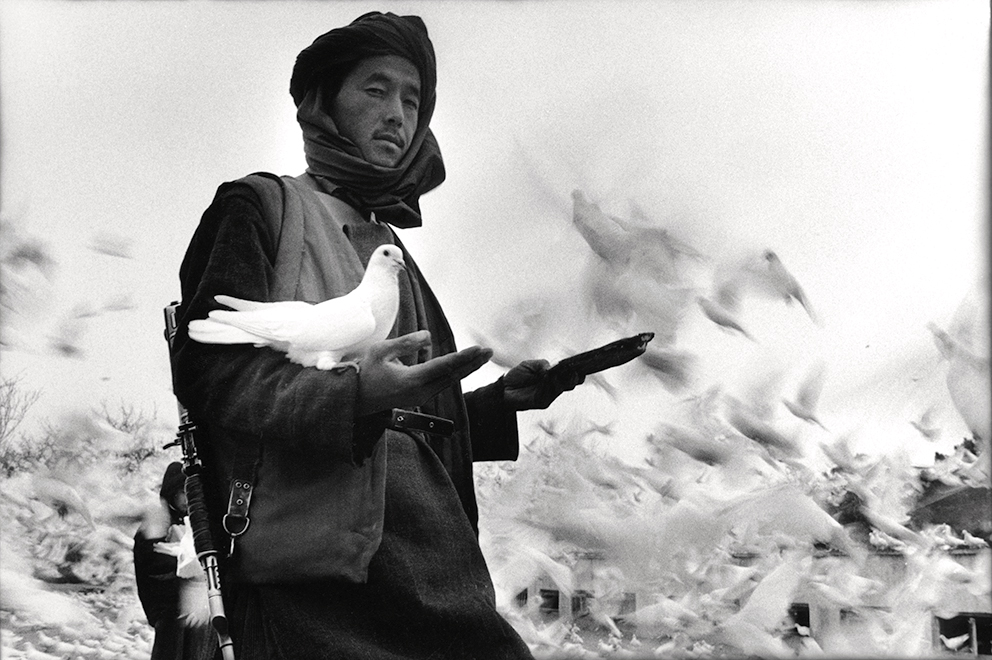
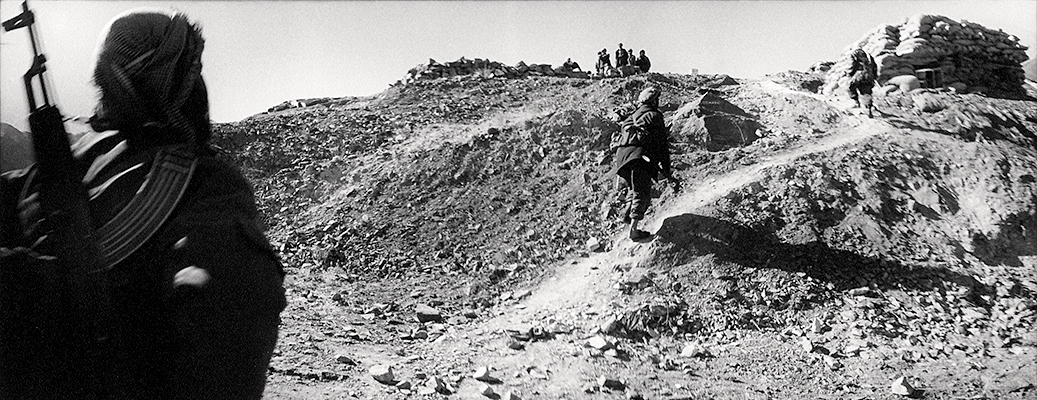




Koordinaten der jeweiligen Orte
Texte zu den Tagebuchseiten (12) jeweils von Habbo
Konzept/Ansatz
Vielschichtigkeit
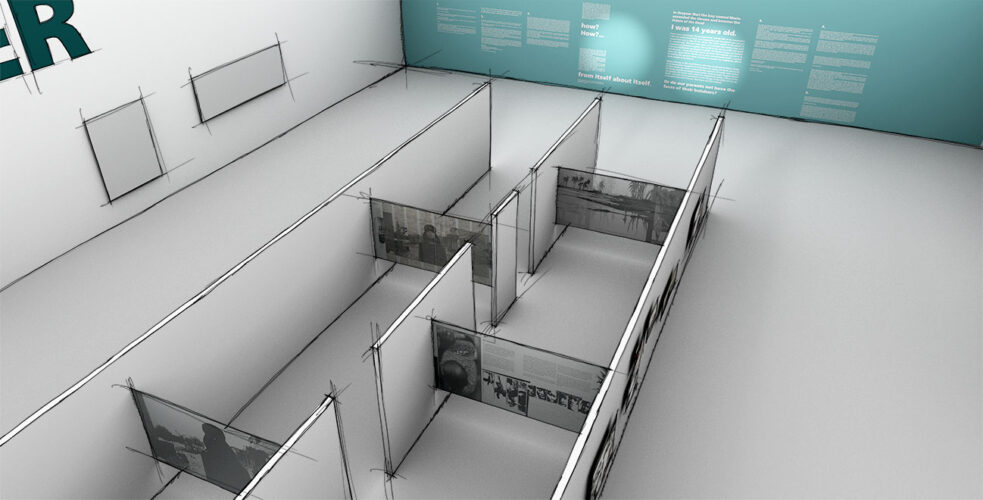
compression and deconstruction
transformation into another dimension of artwork as diaristic collages and text fragments
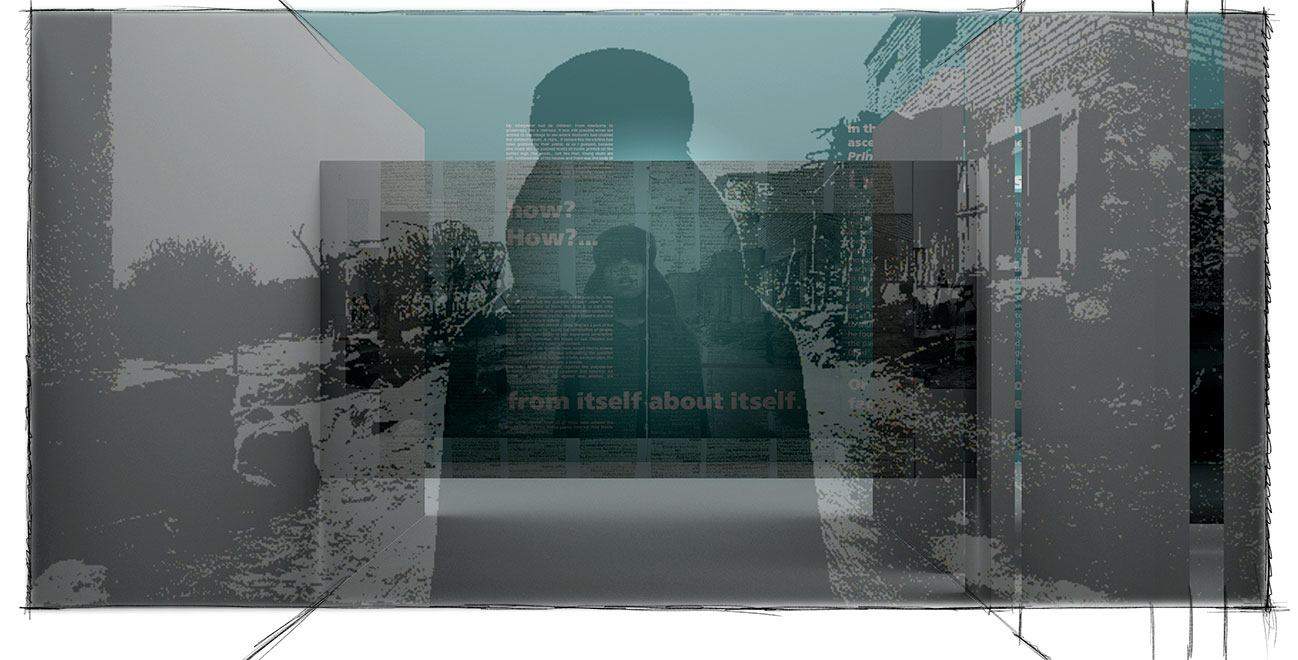
Constitutive for my work is a continuous interplay between photography‘s objectifying potential and its personal conversion into visual palimpsests that represent our inability to finally grasp the physical and structural, the visible and invisible violence I have been confronted with. For me, the open-shut-down-moment of the camera is a liminal stimulus to engage with the intrinsic limitations of photography as a documentary genre in order to disclose myriad ways to perceive realities
.…













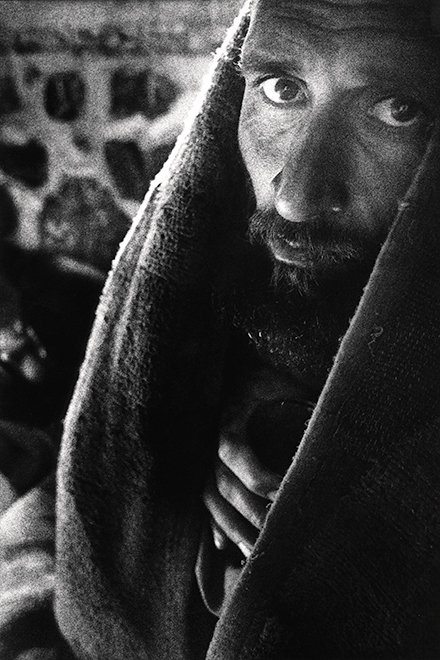







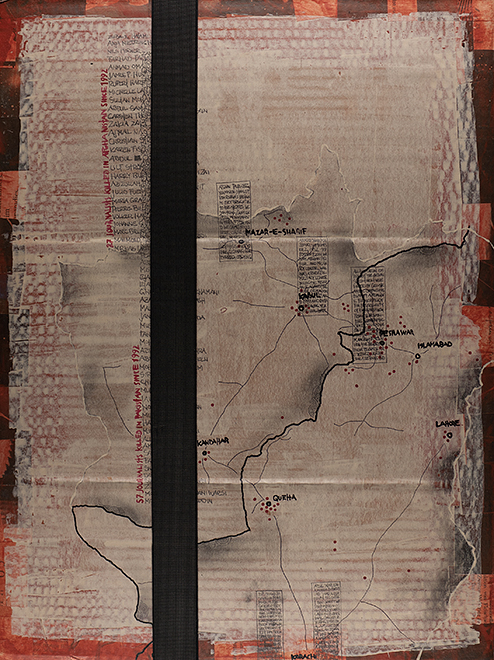




19. Jahrhundert gewonnen. Seit 1979 wiederholt es sich: Peshawar hat sich explosionsartig ins brandgefährliche Epizentrum islamistischen Terrors verwandelt. Schon 2001 fiel ihm der „Löwe vom Pandjshir“ im Widerstand gegen die Taliban zum Opfer, Ahmad Schah Massoud, die Hoffnung der muslimischen Demokraten. Wie eine Metapher auf diese Gewalt lieben die Menschen in Peshawar das traditionelle Buzkashi. Als gäbe es kein Morgen wird vom Pferd aus um einen toten Ziegenkörper gerungen. Die Reiter sind Abhängige: Reiche Clans verbinden Bestechung, Glückspiel und Geldwäsche mit dem Kampf um Ehre und Macht. Ein paar Schritte, wenige Momente weiter wird aus dem gespielten Krieg – blutiger Ernst.

<< Afghanistan
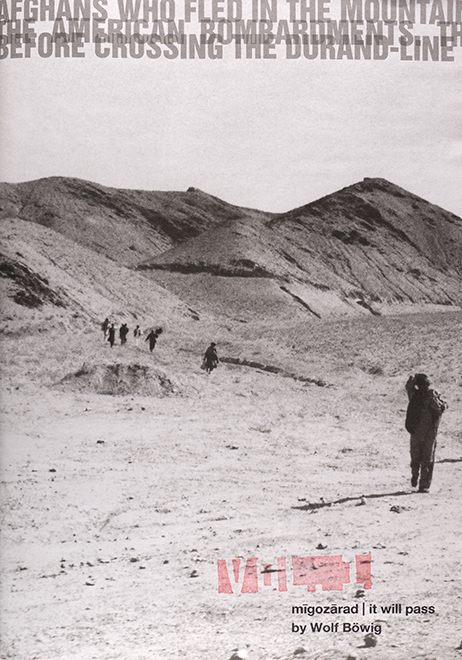
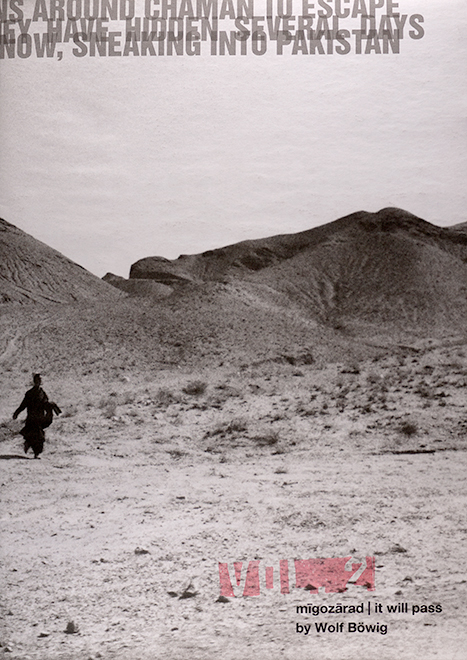
Grenze / und keine Grenze
zwischen Afghanistan und Pakistan
Pakistan >>











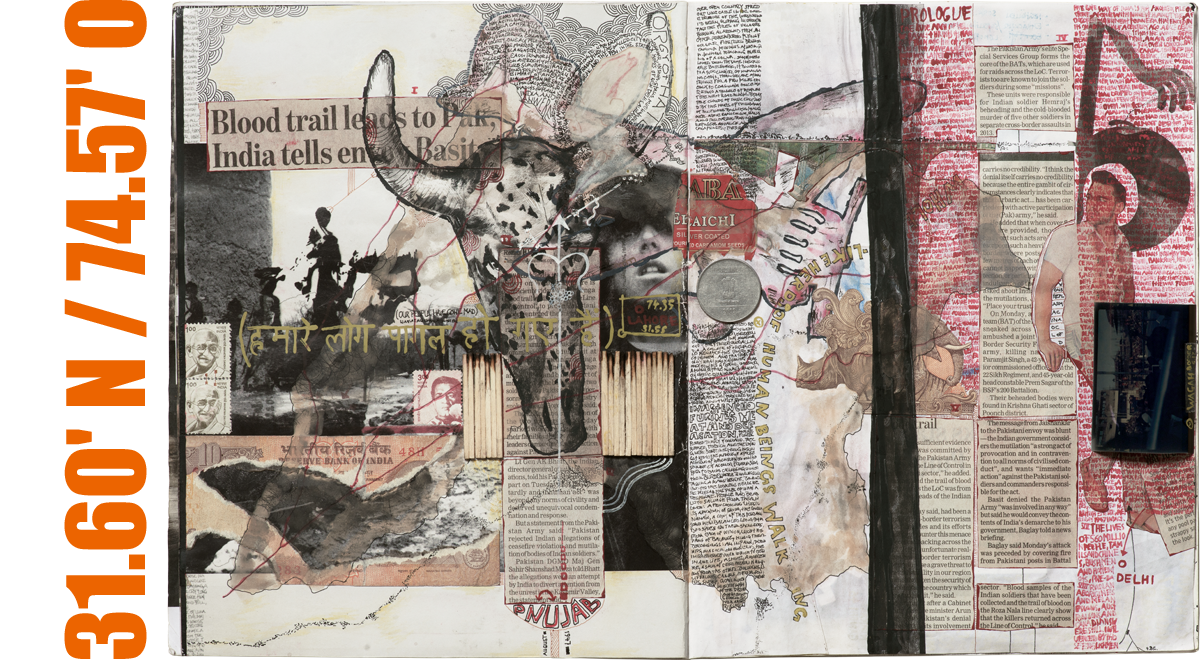
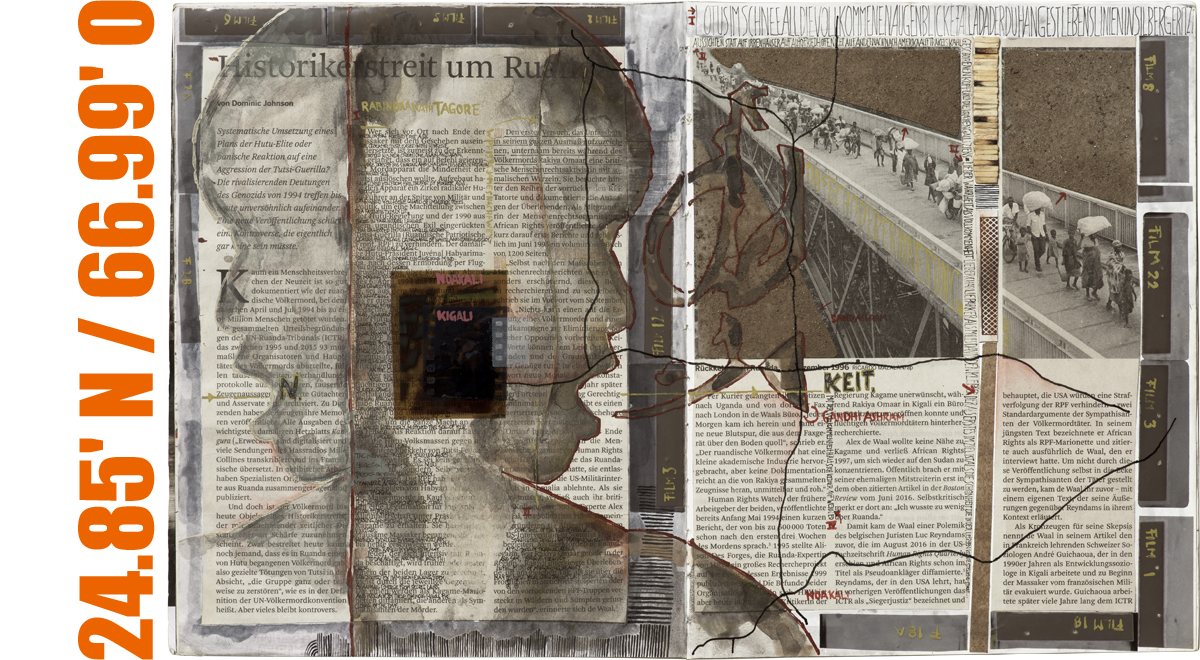

Indien >>










Entwurf Doppelseiten
für Publikation
(Verdichtungen)

die 7 folgenden Doppelseiten sind als Entwurf für eine Umsetzung des vorhandenen Materials gedacht (Foto und Collage von Wolf, Texte von Habbo, alles im Dialog mit Text von Marko)
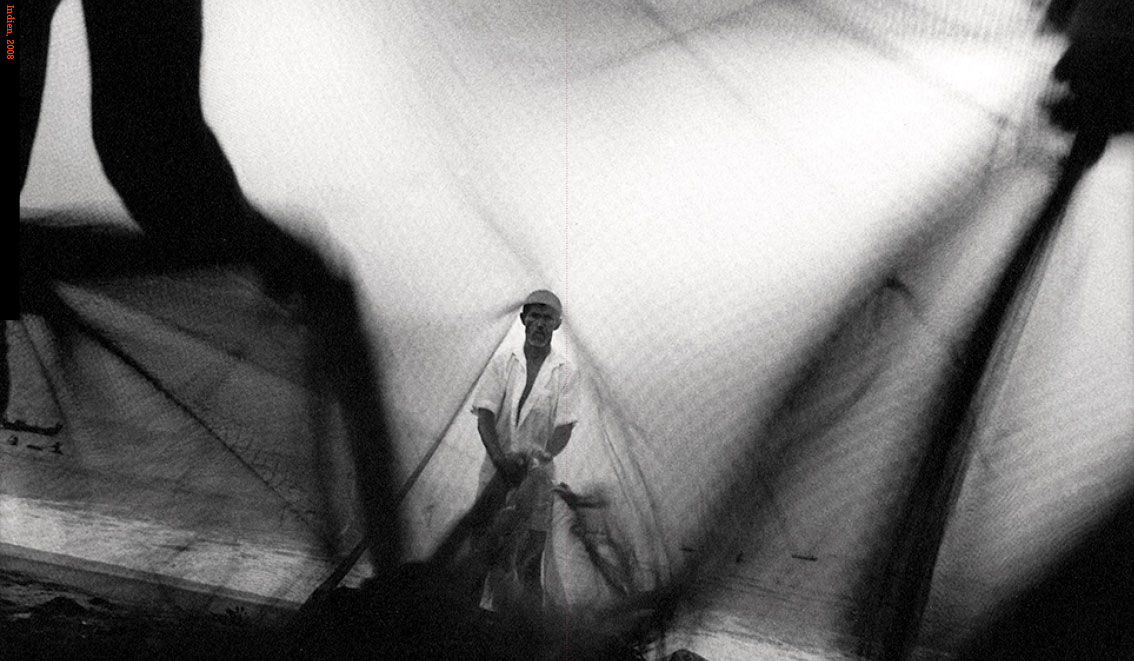
Buchprojekt
Beispielseite (Entwurf)
Foto ganzseitig mit Legende
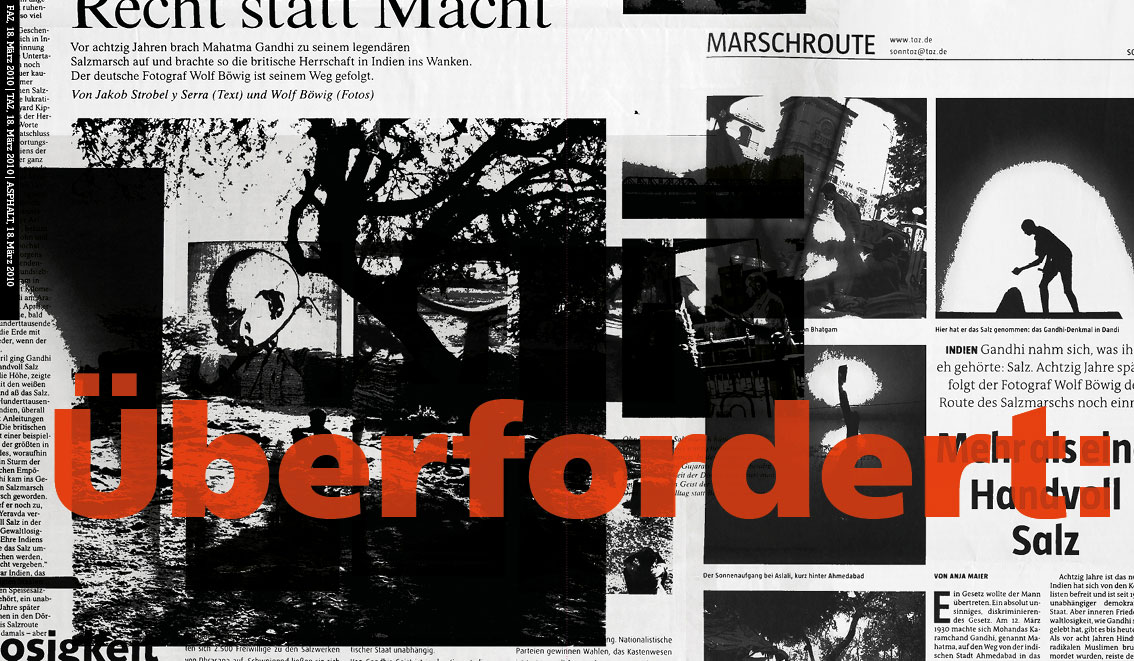
Buchprojekt
Beispielseite (Entwurf)
Collage aus bestehendem Material (Zeitungs- und Magazin-Ausschnitte), überdruckt im Siebdruck
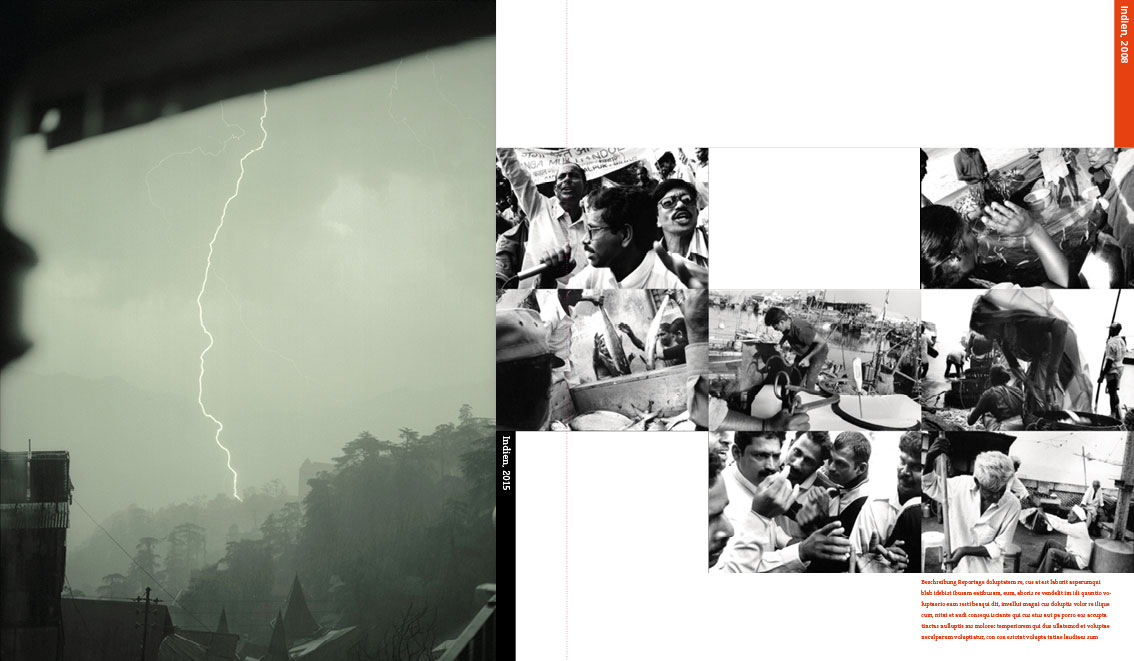
Buchprojekt
Beispielseite (Entwurf)
editierte Fotos mit Legende, Text
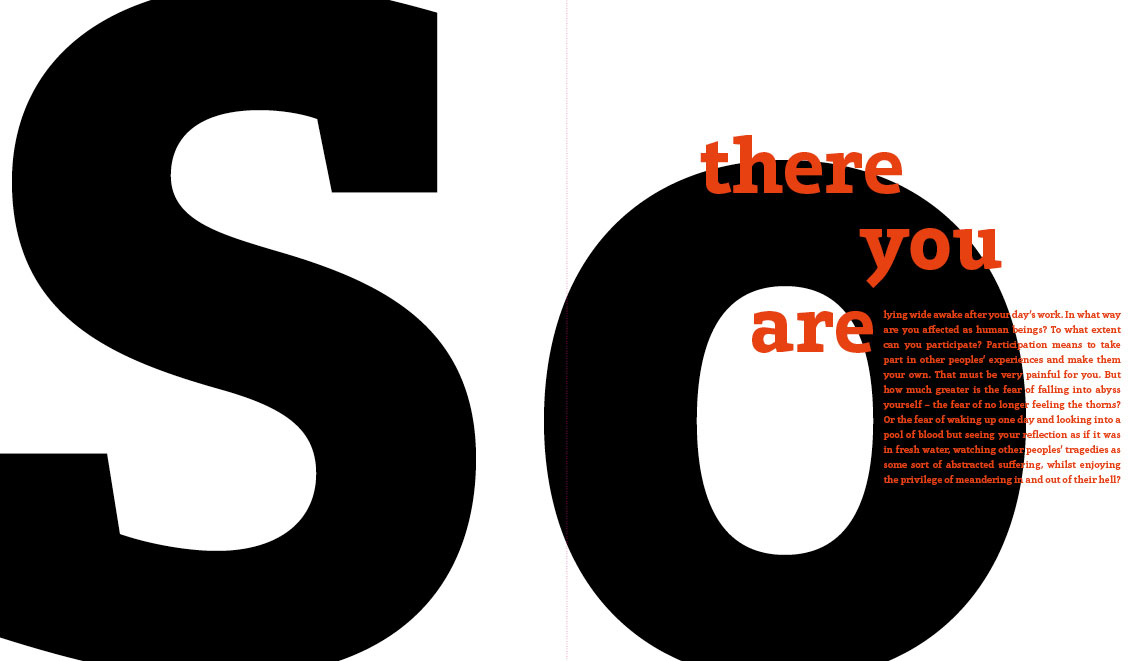
Buchprojekt
Beispielseite (Entwurf)
Text(-Dialog)
dialogue Mendes | Dinić
„
…
My interpreter had six children. From newborns to grown-ups, like a staircase. It was still possible when we arrived to the village to see where Dostum’s had crushed the children’s skulls. A stain… It looked like the victims had been grabbed by their ankles, or so I guessed, because one could still see purpled marks of hands printed on the babies’ legs. The heads… Just like that. Young skulls are soft. I entered one of the houses and there was the body of a girl. I couldn’t exactly understand what happened with her since her dress was folded back, covering her head. I mean, the place of her head. My interpreter cried out, desperate. He cried and cried and cried. I walked outside and raised my hands high:
how? How?…
…
“
How is the key question in art. In the search for form, the artist must ask the question of how? How is the natural predecessor of form. The form is as such cold. Form is an experiment. To augment form with content is a further level in artistic creation. To have found a universal language is already a culture.
An example: children are not a form, they are a part of the story. In them is to be found the culmination of people, place, events, both happy or sad, dependent on whether these events themselves are happy of sad. Children can viewed as being of a tapestry of content.
Heads and skulls are forms. In them, nature tries to answer the question of how, without articulating the question aloud. In a similar way, a dress is a form, an organ pipe, the number 6 or a scream, a scream, a scream.
The forms holds the content together like purpose-built mould. The artist is a carpenter and collector. All stories are collected, rub against one another, are assessed – the art learns from itself about itself. The art is smarter than all of those who created the mould. If the mould breaks, then our story breaks too. Culture – nowhere.
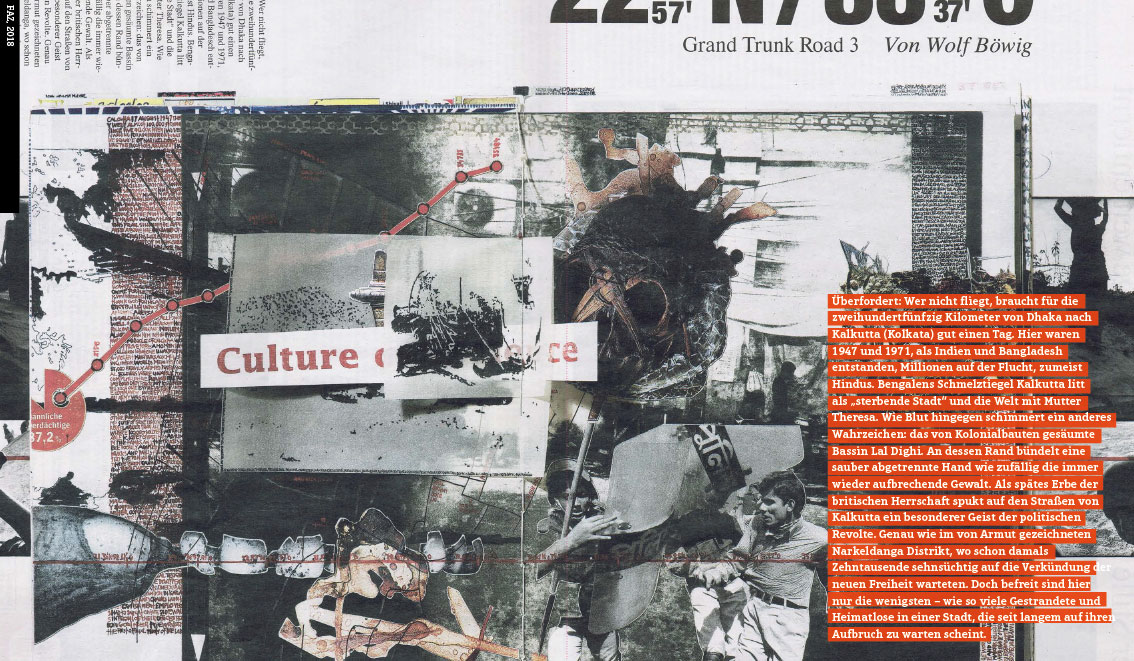
Buchprojekt
Beispielseite (Entwurf)
Tagebuchseite (FAZ) mit Text Habbbo
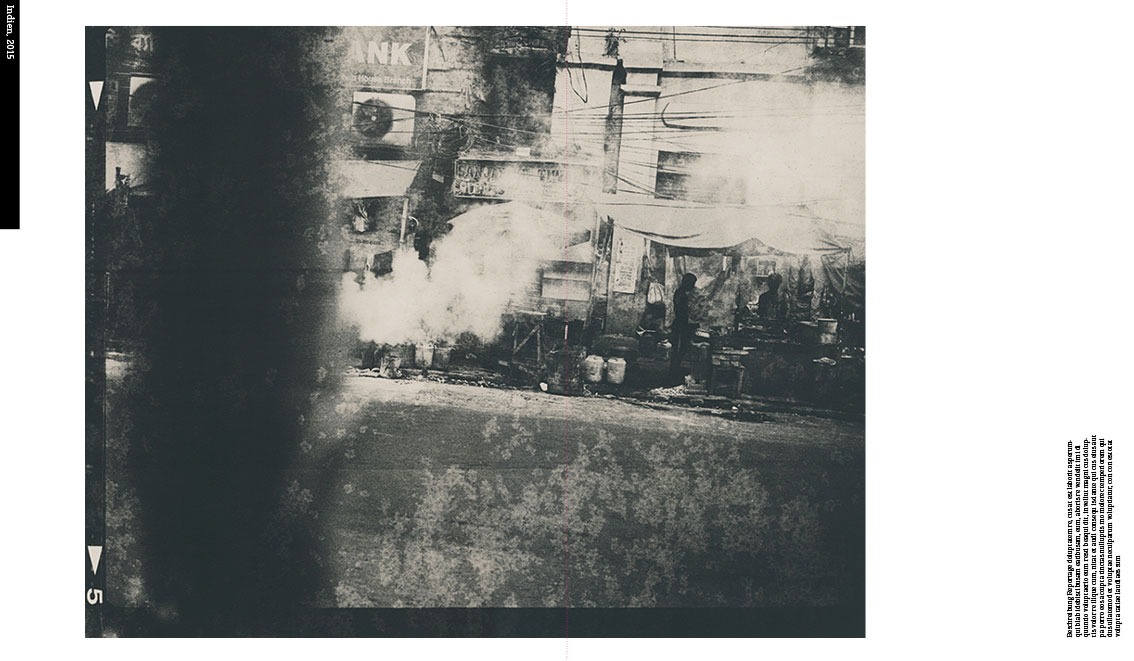
Buchprojekt
Beispielseite (Entwurf)
Foto ganzseitig mit Legende
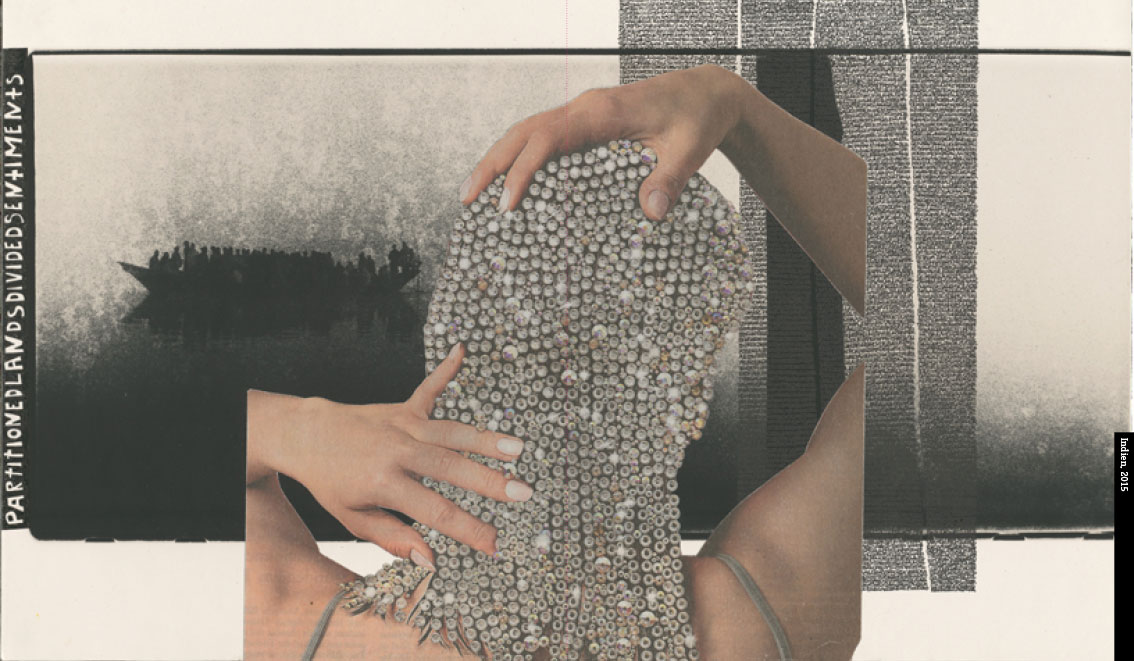
Buchprojekt
Beispielseite (Entwurf)
Foto ganzseitig mit Legende
dialogue Mendes | Dinić
„
…
the rebels made him look for and find his father, after which they put the infant on top of his corpse and declared the boy ‘Prince of the Dead’.
…
“
In the year that the boy named Morie ascended the throne and become the Prince of the Dead I was 14 years old.
Some years previously, the ground shook. Bombs fell on my hometown. I did not understand what was happening and the grown ups just grimaced – that was a sign of the times. The child looked at the world in its normal way. We and they were not concepts but words. And until someone consented to explain the words to us, we we could not speak with our neighbours, our dealers in death. At 14 years of age, we had just moved west, I knew all of the words by heart. But nobody was there to warn me about them. Words are in fact contaminated bodies, capable to making the ground shake and able to murder my neighbour. Words cause people to be shot at.
Morie, the boy on the cruel throne, who was previously his father, knew, or, at least today I imagine it to have been so, today, as I try to use words to shut words up, Morie understood the capacity of words, even before he found someone to explain them to him. Early enough, he got to know the people, the horror with which he weighed his words: „Prince of the Dead“. Just one more installment in the lineage of the killers of our parents with them their history, their faces and their culture.
Or do our parents not have the faces of their butchers?


Sri Lanka >>


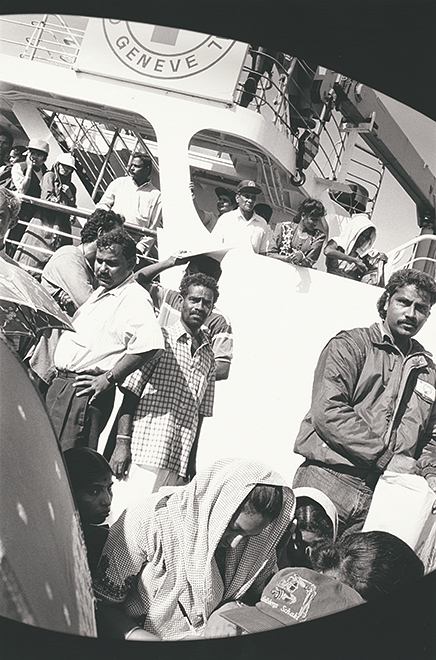
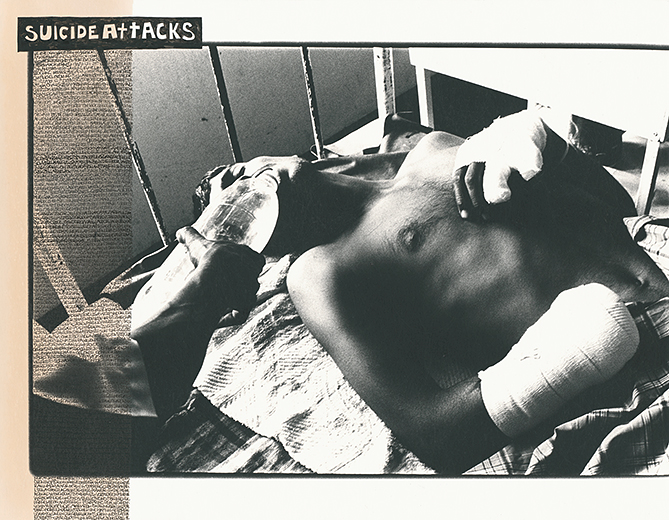

Bangladesch >>
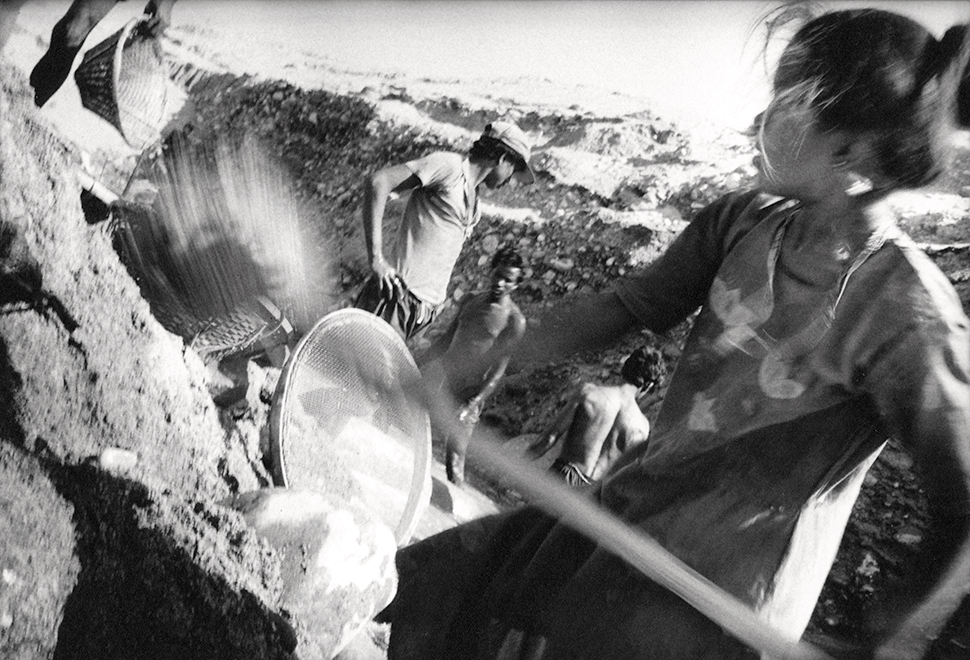

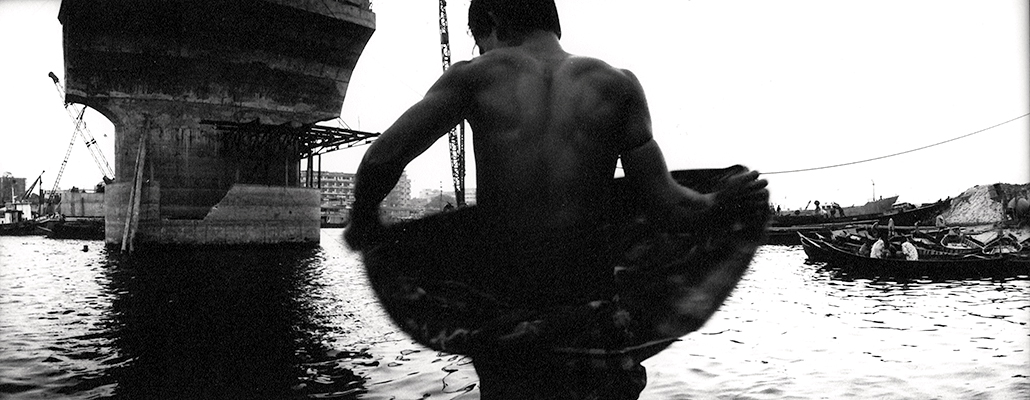
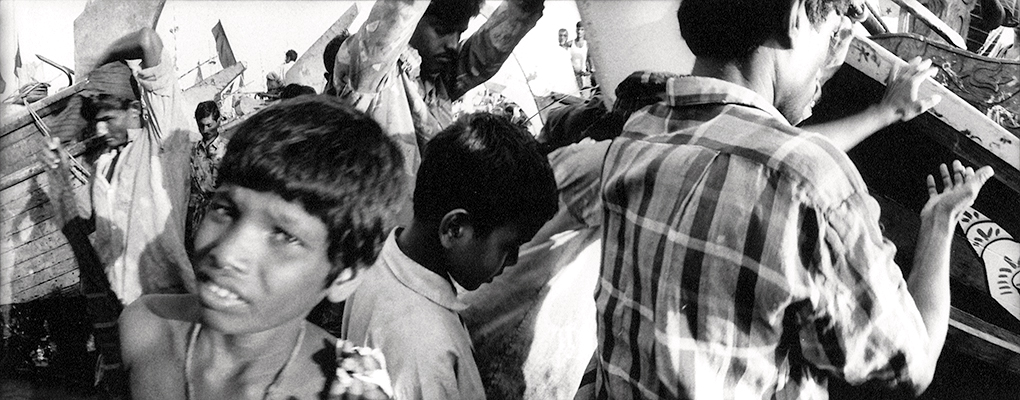
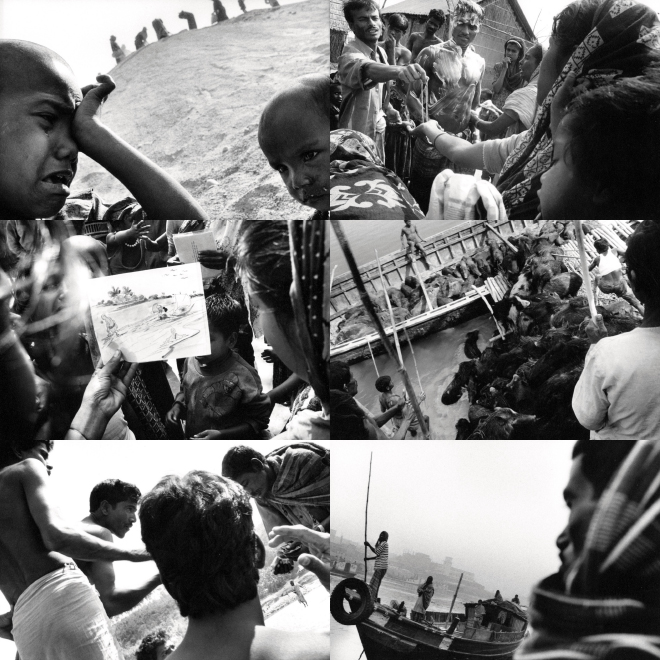
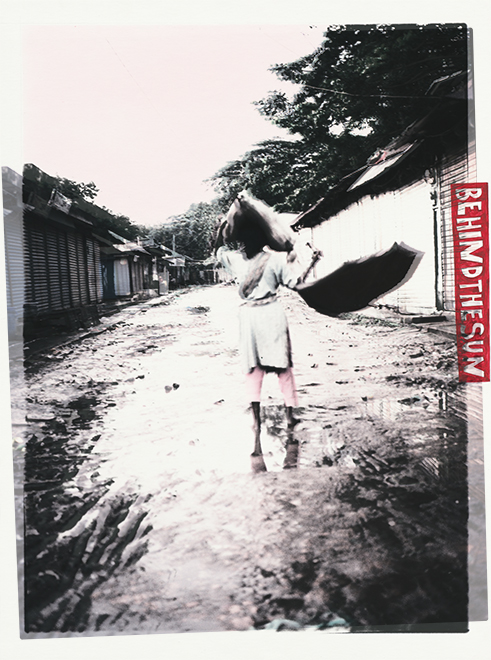
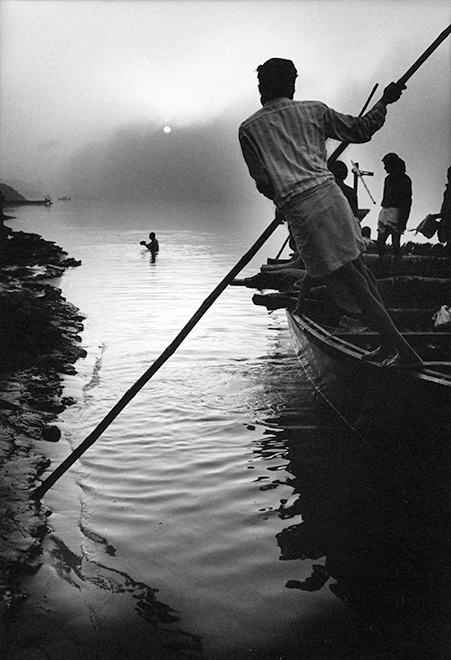
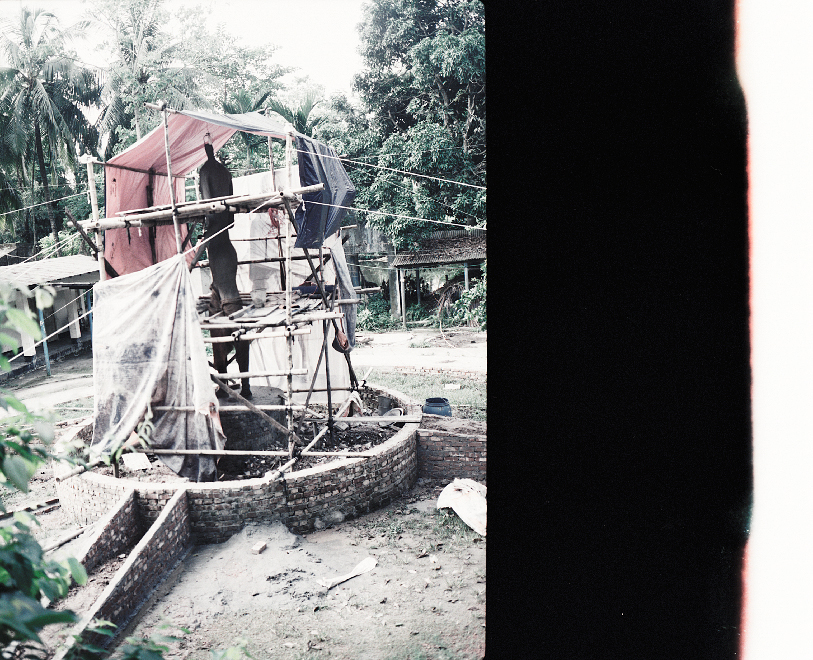
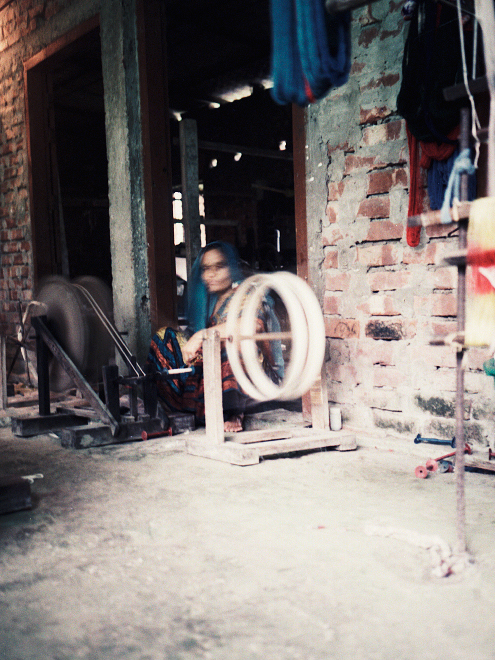
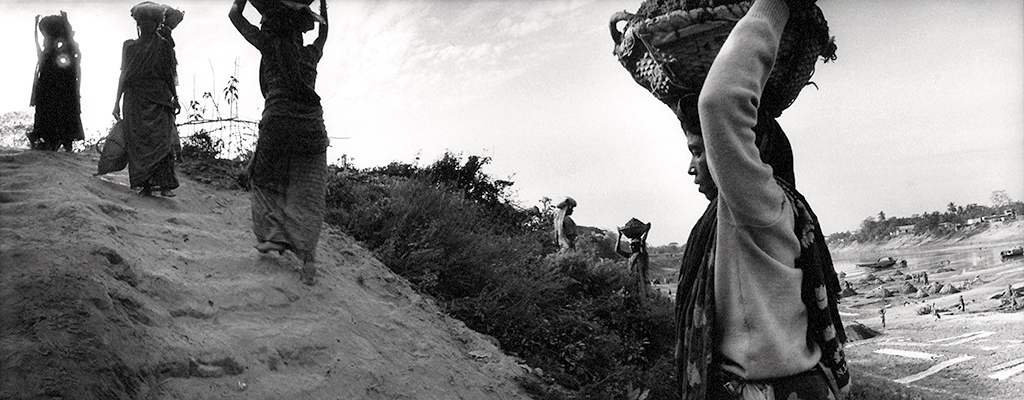
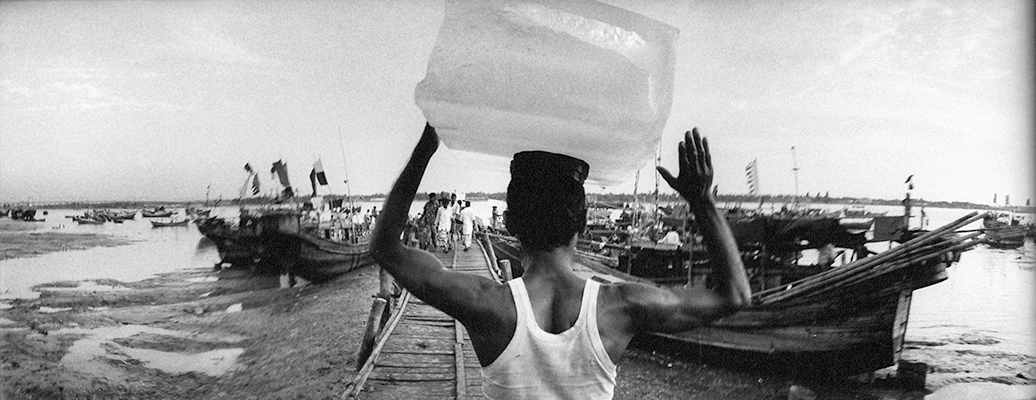
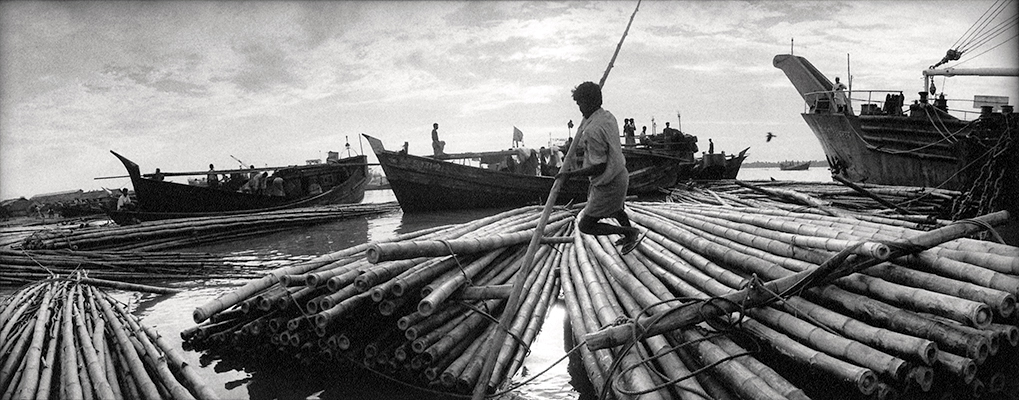

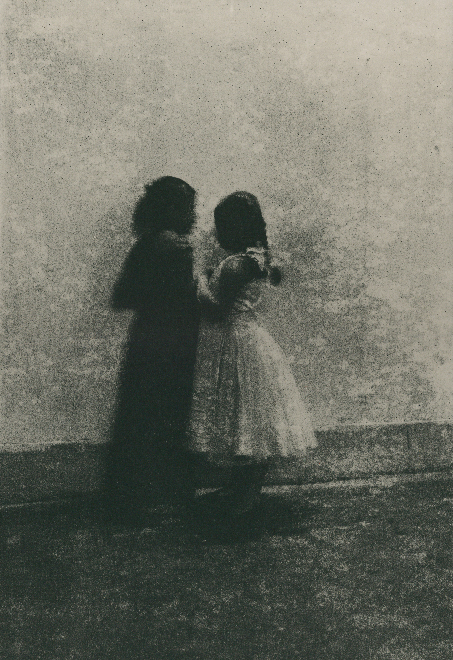
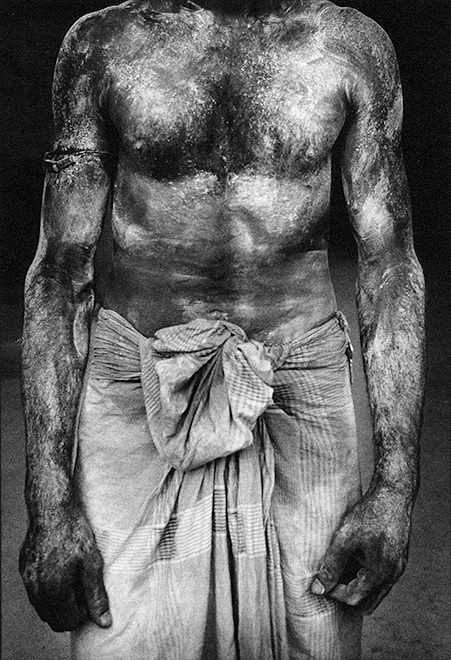
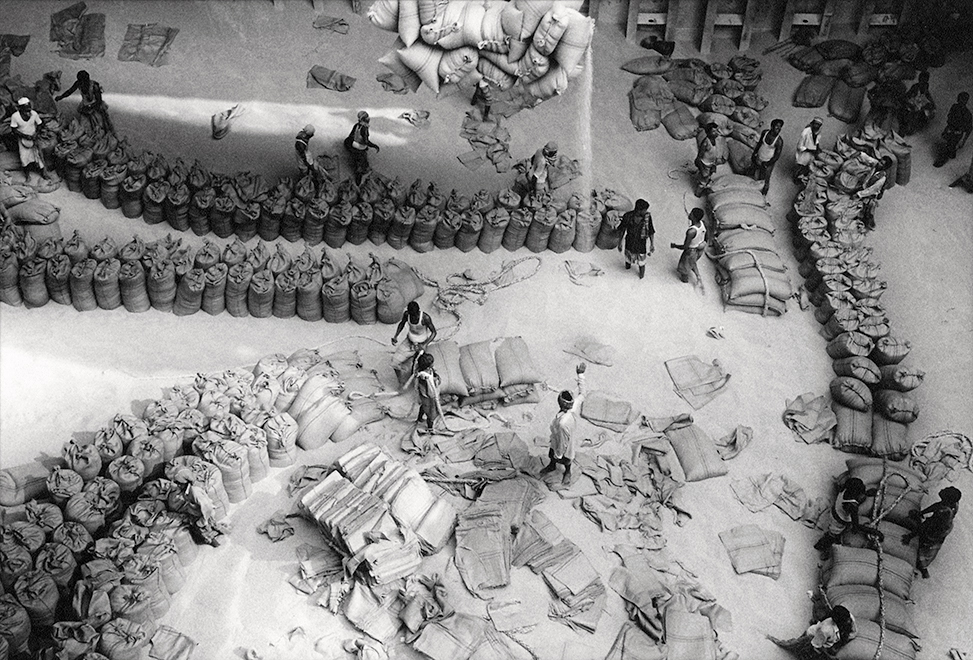
Burma >>
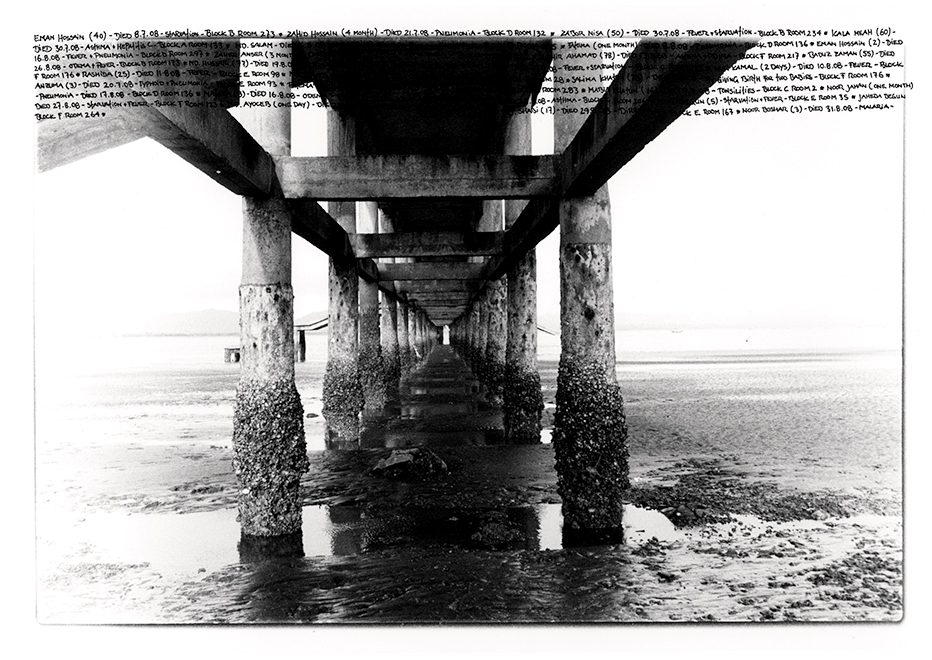
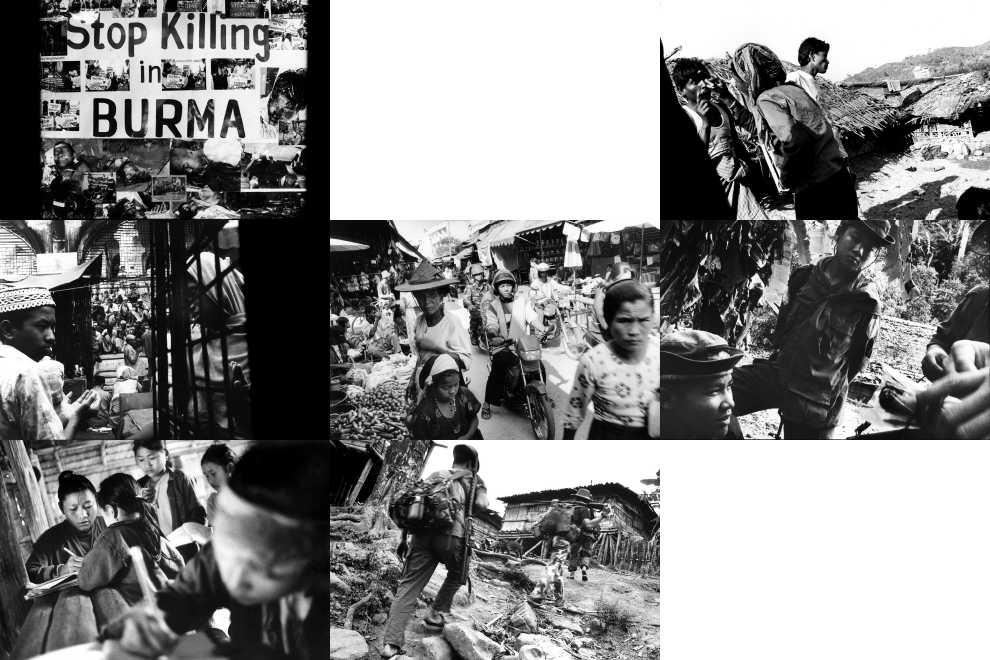
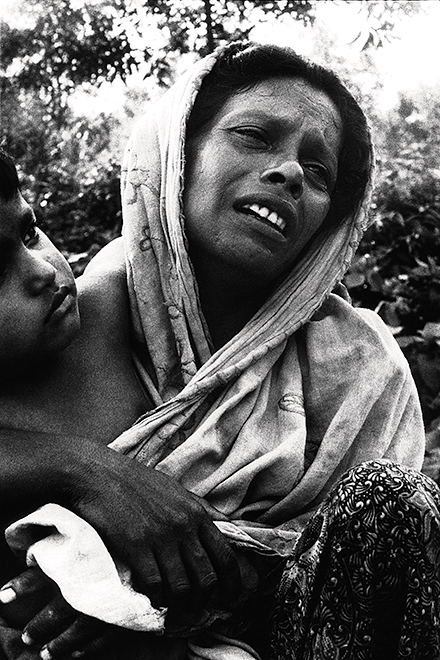
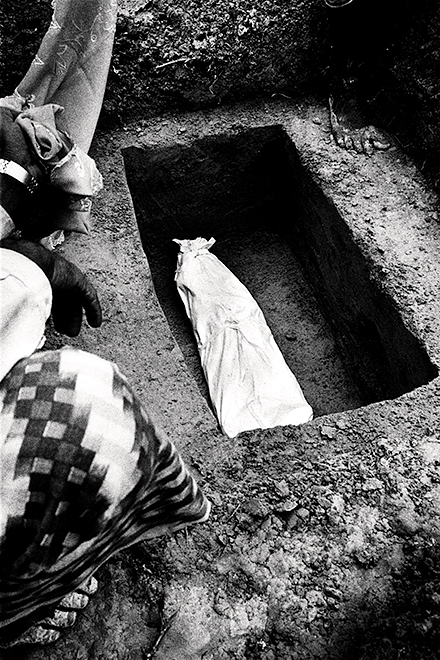
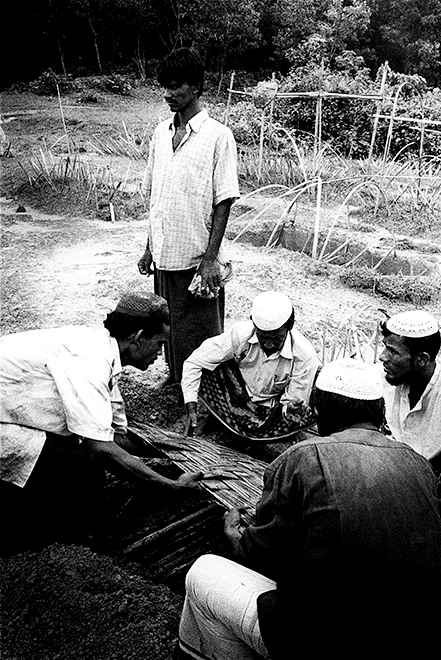
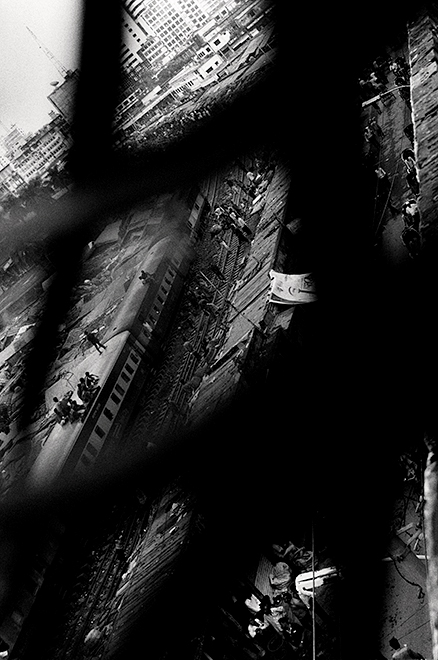
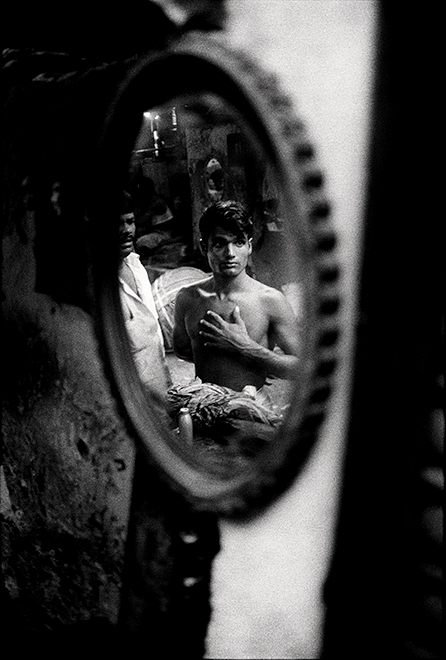
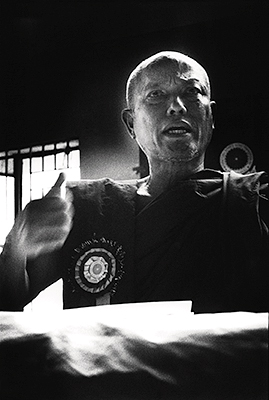
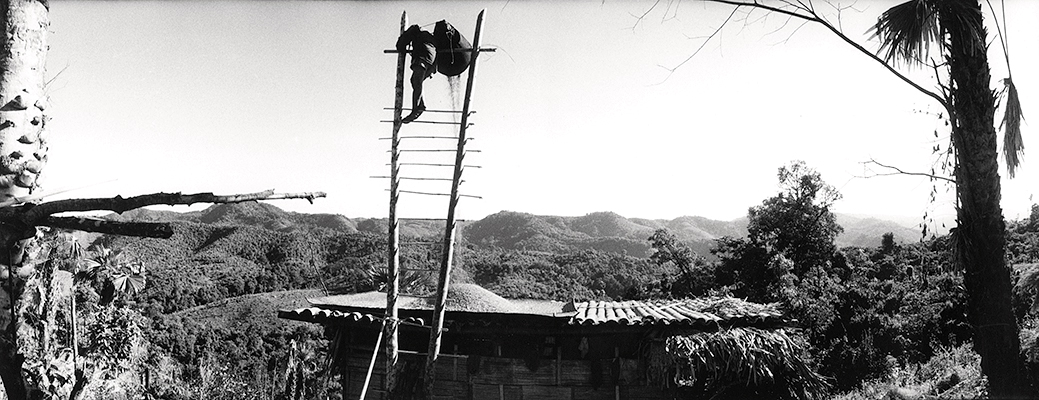
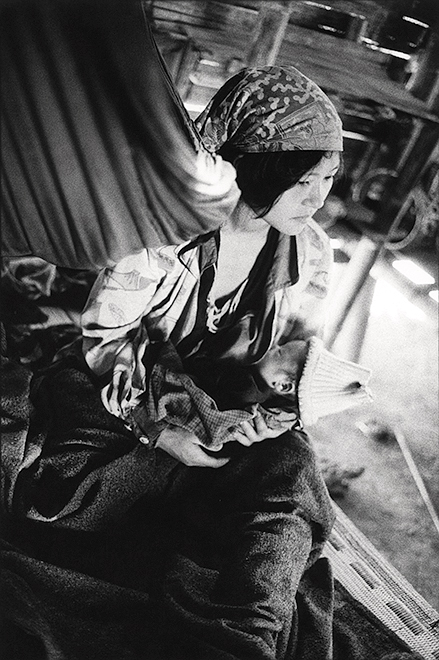
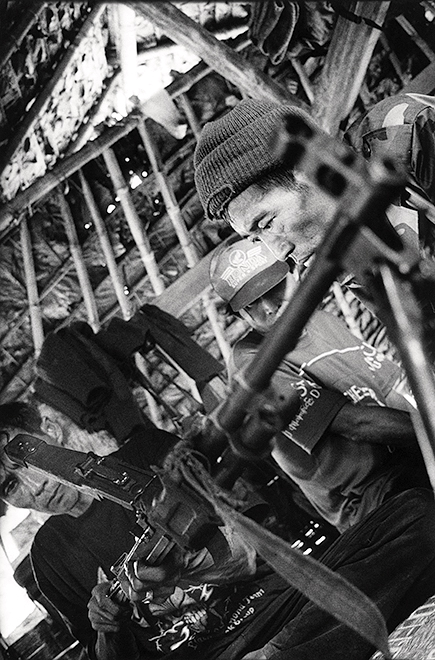
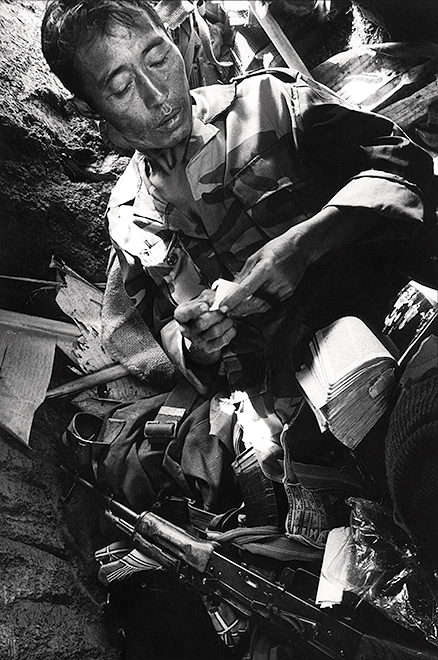
Text von Pedro Rosa Mendes
FAZ Januar 2018

Being true, eye to eye
1.
It rained forever the whole night. There was no other sound other than a woman weeping or praying or begging,
„I did not, I did not, I did not“
in the house next to our miserable hotel, the Dokone, formerly the Florida before the war ravaged the old quarters of Mamba Point in Monrovia.
From one of my notebooks :
“12 November 2003. There is no light. Wolf lyes flat in bed, on hisboxers. He meditates. The woman stopped crying after I shouted
Stop it!
to the darkness and the rain. I shouted to the man beating the woman with a belt, or with a whip. Eventually, Wolf rises and sits. He starts recalling:
‘There was an offensive from the Northern Alliance against an area under Taliban control but which was not affiliated with their regime. There was a bizarre military alliance between enemies back then. General Dostum’s forces stormed the region, including the village from where my interpreter came from. Everything was brought down. When we reached the village, my interpreter looked for his house. Dostum’s men had killed is entire family. My interpreter had six children. From newborns to grown-ups, like a staircase. It was still possible when we arrived to the village to see where Dostum’s had crushed the children’s skulls. A stain… It looked like the victims had been grabbed by their ankles, or so I guessed, because one could still see purpled marks of hands printed on the babies’ legs. The heads… Just like that. Young skulls are soft. I entered one of the houses and there was the body of a girl. I couldn’t exactly understand what happened with her since her dress was folded back, covering her head. I mean, the place of her head. My interpreter cried out, desperate. He cried
Text hier eingeben and cried and cried. I walked outside and raised my hands high:
how? How?…
It was winter. It was Winter 2001. Everything was frozen. I tried to dig a grave for my interpreter’s children. I didn’t succeed. Everything was frozen. I remained with him for three days”.
2.
On 23 July, 1939, Gandhi wrote a short letter to “the one person in the world who can prevent a war which may reduce humanity to the savage state” – that person being Herr Hitler.
“Will you listen to the appeal of one who has deliberately shunned the method of war not without considerable success?”
Whatever response, if any, to Gandhi’s letter, History provides an extensive illustration to what became a cause of distress and almost mental disruption to Gandhi: the realization of his own impotence in the face of mass slaughter. (He wrote a second letter to Hitler a few months later.)
Rabindranath Tagore, for whom Gandhi nurtured a mutual deep admiration and affection, identified on his nonviolent resistance “the fierce joy of annihilation”.
Gandhi didn’t fear death and kept that moral contempt alight until his very last moments, when a fateful, violent end to his life became more and more plausible in the weeks proceeding his assassination by an Hindu extremist in 30 January 1948.
The outbreak of religious and communal violence in the context of India’s independence and Partition heightened a sense of melancholy to Gandhi’s last months. The Great Soul would walk by the communities of Bengal and then Bihar, his bleeding feet walking on narrow paths tainted with the blood of Hindus and Muslims, his nonviolent stand met with growing hostility. One time, a Muslim spat on his face; Gandhi kept walking. He would kept walking every morning, from village to village, often singing Tagore’s creepy song:
Walk alone.
If they answer not thy call, walk alone;
If they are afraid and cower mutely facing the wall,
O thou of evil luck,
Open thy mind and speak out alone.
3.
Most of the time that me and Wolf spent together on assignment, documenting the suffering caused by Charles Taylor in West Africa, we were wearing the skin of journalists. I still entertained back then, as I did for many years, that objectivity, neutrality and personal detachment would honor human suffering in terms that could render it morally tangible to strangers. I think Wolf knew best all along about the limits of objectivity and how radical a commitment you have to take to honor your intentions – to be morally loyal to your program of work in a way that makes it coherent and one whole with your program of life. I thought of Wolf, and his work, when reading a passage of Pankaj Mishra (on his An End to Suffering) about how Nietzsche and Buddha attempted similarly to reaffirm the natural dignity of human beings without recourse to metaphysics, theology, reason or political idealism. As acknowledged by Nietzsche on Buddha, in Anti-Christ:
“The spiritual weariness he discovered and which itself as an excessive ‘objectivity’ (that is to say weakening of individual interest, loss of centre of gravity, of ‘egoism’), he combated by directing even the spiritual
interests back to the individual person. In the teaching of the Buddha, egoism becomes a duty: the one thing ‘needful’, the ‘how can you get rid of suffering’ regulates and circunscribes the entire spiritual diet”.
I strongly believe – having never discussed this much with him – that Wolf’s uniqueness derives from his photojournalism being a radical form of self-overcoming. He’s saved from nihilism albeit living a lifetime in close encounters with different forms of human bestiality. There is thus a quality of the superman who built “a power over oneself and over fate”, which has “penetrated to the profoundest depths and become instinct” (On the Genealogy of Morals).
4.
T.E. Lawrence, whom we are both very fond of, sensed madness near, even if in the form of wisdom and alterity, as “it would be near to the man who could see things through the veils at once of two customs, two cultures, two environments” (Seven Pillars of Wisdom).
Borderlines of all kinds, from mental to political to cultural, are central to Wolf’s account of the human
nature we all inhabit and share. It is that inherent madness that he crudely displays, with layers of historical, political, emotional and linguistic complexity.
Throughout Wolf’s extensive body of work, human reality emerges as revelation, vary rarely as exposure, whereby each photographic moment captures the accumulation of references that define a sense of individual, collective and social identity – identity being that ultimate sovereign form of madness over one’s self.
Displacement, deportation, exile, exclusion, elimination, derangement and, hélas!, genocide (a distopian form of negative identitarian enterprise) are abundant throughout Wolf’s coverage of present and past human tragedies. He himself is not immune to the unpredictable ways on which – as in many stories we pursued together – collective memories can strike the nerve of individual narratives of belonging.
I still vividly remember the moment Wolf and myself made it from Monrovia to Gbarnga, upcountry, in November 2003, when combats still raged across St. Johns River. The United Nations peacekeeping mission controlled only a strech of 50 km out of the capital. Gbarnga, as most of infrastructure in the Eastern and Northern counties, had been raised to the ground during the civil war. When we arrived, people were collecting debris from the ruins and organizing it on small piles of catalogued rubbish: window frames here, reusable bricks there, doors somewhere else, lockers and other metal remains in yet another pile. I sensed something crumbling silently inside Wolf, as buildings implode inside even when the external walls keep standing.
We did this after the war.
In Germany, he meant.
There was a pile for books as well: a copy of an English translation of Dostoievsky’s The Idiot survived the bombing of a secondary school.
In Liberia, I mean.
I held on to it, for sanity.
5.
Months before, we followed the Truth and Reconciliation Commission from Sierra Leone for the provincial audiences, including to some of the districts
where the RUF hailed and ruled. The plan was to then proceed to Liberia and continue our assignment there. On the eve of our scheduled departure from Sierra Leone, we sat with TRC’s president, Bishop Humper, and listened informally to his recollections of the many intense moments among victims and perpetrators.
The cleric told us that he was particulary disturbed by the story of Morie,a boy from the Pujehun district in the remote Southwest of the country. Morie was four or five years old (he was born in 1992 or 1993) when is village, Bendu Malen, was attacked by RUF rebels in retaliation of an earlier attack by a group of Kamajohs, who were part of the Civil Defence Forces. The RUF isolated the village, stormed it and killed everyone (up to 1.200 people according to TRC official estimates) but one person: Morie. He was spared out of pure cruelty: the rebels made him look for and find his father, after which they put the infant on top of his corpse and declared the boy ‘Prince of the Dead’.
With much arguing, we decided to drop the flight next day to Monrovia and instead to look for Morie through the contact given by Humper of a priest in a remote mission. A helicopter from the UN mission literally left us in a clearing of the thick Pujehun forest, a couple of days later. We were somewhere down there when we heard the news that the final attack of LURD on Monrovia had started. I was frustrated, Wolf was furious: we had just lost the opportunity to be in the right place at the right time (journalistically speaking).
Or so it seemed.
We eventually found Morie through Father John Garrick, a catholic priest that went through the horrors of the civil war in Pujehun. We visited Bendu Malen and collected more pieces of Morie’s story. Morie became central to both Wolf’s career in the last fifteen years and a resilient thread cutting across my own work in doumenting violence and my search for the right language to capture it – on others and on myself.
I never saw Morie again. Wolf did, visiting him in Pujehun twice in the years after. That is a feature of him: Wolf documented the upbringing of someone
who grew up with the ultimate wisdom of the absolute erasure of what was the world of a five year old. Or of what we can imagine of it from Morie’s own sparse memories. „In the middle of everyone, the chicken, the dogs, the goats – all killed…”Among the Ashokan inscriptions presumably originally from Kandahar (Zor
Shar in Pashto; Shar-i-Kona in Farsi) there is an Edit, a rectangular limestone block, containing 22 lines of an incomplete Greek inscription that starts: “…piety and self-mastery in all the schools of thought; and he who is master of his tongue is most master of himself” (as taken from R.E.M. Wheeler by Louis Dupree for his Afghanistan, from 1973). How many Alexandrias run in the blood of each new massacre down the Durand Line, I ask to myself looking at Wolf’s significant Afghan-Pak-Indian portfolio? No digression here, all is continuity seen through Wolf’s lens. For instance: thinking of us interviewing Morie, I see Gandhi on one of his silent days, on Mondays, making a silent statement to a crowd of reporters that, at his feet, diligently recored the nonspoken eloquence of nonviolence.
6.
I keep my Taylorland notebooks on a wooden ark, a fine carpentry work from Guinea-Bissau. My father commissioned this ark to a local carpenter in Southern Guinea-Bissau before I was born, in the mid-1960s, a most difficult period when he, as many young men of his generation in Portugal, were assigned to fight for the regime against the freedom fighters of PAIGC. The ark would be
My coffin or your vessel
as he would explain to me many years after. From my father, I also first heard about men who, in the same region, cured bad dreams and bad diseases by washing their heads on a solution of sacred words. They would write Coranic verses in wooden plaques, wash the plaques in a bucket until the ink dissolve in the water, and then pass their wet hands in their foreheads. Wolf manages a similar epiphany but using the inversed chemistry: our nightmares and fears are captured in the lives of others. Then, through revelation – a magic practice which Wolf never gave up -, they are offered to us in the form of supranatural strenght, divine wisdom, and intemporal grace. They flow back from light and onto an emulsion of black and white images – and, in Wolf’s most recent work, of lettering and caligraphy. From coffin to vessel, photography being true, eye to eye.
